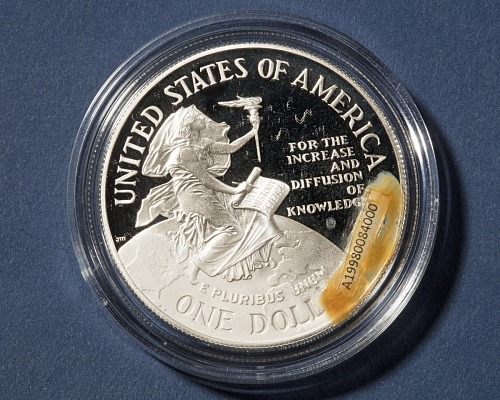What’s the deal with cardboard pennies and which United States president graces the $100 bill? On March 18, 1961, the Smithsonian hosted a reception for the opening of the newly-reorganized monetary hall in the Arts and Industries Building. According to its curators, the exhibition featured a new approach to exhibiting numismatics. Rather than arranginging the 8,000 to 9,000 objects by conventional classification, coins and currency were displayed in their historical context. Who was the great organizer supervising this new exhibit?

Though small in stature, scholar and curator Elvira Clain-Stefanelli was a force to be reckoned with at the Smithsonian from 1957 to 2000. She secured her role at the Institution in the same way that many other women gained access at that time—through her husband. Clain-Stefanelli became an assistant to her spouse, Vladmir Clain-Stefanelli, who had been hired as the curator of the National Numismatic Collection in 1956.
Together, the couple vigorously expanded the collection from 60,000 pieces to one million. In 1973, they were presented with the Secretary’s Gold Medal for Exceptional Service, the highest honor awarded to Smithsonian staff.

At the Institution, Elvira Clain-Stefanelli rose through the ranks, earning spots as associate curator, curator, and finally, two years after her husband’s death in 1982, she was appointed the first executive director of the National Numismatic Collection.
What led Clain-Stefanelli to thrive in the male-dominated field of numismatics? To put it simply, she was a survivor.
Clain-Stefanelli was no stranger to severe hardships prior to her career at the Smithsonian. During World War I, she and her family were forced to flee their village as troops invaded Romania. During World War II, Elvira and Vladimir Clain-Stefanelli were researching coins in Germany when the Gestapo apprehended Vladimir in 1942. He was then sent to Buchenwald concentration camp, where he was "a guest" until the end of World War II. Elvira, then pregnant, chose to join him in the camp.
Following the war, the Clain-Stefanellis emigrated to Italy and, in 1951, to the United States, where they initially settled in New York. Before their careers at the Institution, the two worked side-by-side at Stack’s Coin Galleries, where Vladimir was a manager and where Elvira wrote her first sales catalog. She became a United States citizen in 1956.

From the time the couple arrived at the Smithsonian, they fought tirelessly for the Institution’s numismatic collections and further established their reputation in the coin-collecting community. They landed one of their biggest deals in 1968, when they accepted a donation of more than 6,000 coins, then worth $5.5 million, that had belonged to industrialist Josiah K. Lilly Jr. After her husband’s death, Elvira Clain-Stefanelli continued to advocate for the Smithsonian. In 1995, she persuaded Congress to lift its moratorium on new commemorative coins, so that the Institution could create and profit from a coin to celebrate the Smithsonian’s 150th anniversary the following year.
In addition to her work at the Institution, Clain-Stefanelli is also remembered for her contributions to scholarship. She published numerous books and articles, including Life in Republican Rome on its Coinage (1999), Numismatic Bibliography (1985), Italian Coin Engravers since 1800 (1965), Numismatics: An Ancient Science (1965), and Russian Gold Coins (1962).
The American Numismatic Association has ensured that Clain-Stefanelli’s legacy lives on through the Elvira Clain-Stefanelli Memorial Award, established in 2013. Each year, the organization presents the award to a woman who has made contributions to research, leadership, or mentorship in the field of numismatics.
Related Resources
- “A Memorial to Clain-Stefanelli,” by Kenneth Bresset, Citizens Commemorative Coin Collection, United States Mint
- “Great Expectations,” by Bill McAllister, 23 August 1996, Washington Post
- Clain-Stefanelli papers, 1938-1972, Archives, American Numismatic Society
- “Elvira Clain-Stefanelli,” obituary, Washington Post
- “Elvira Clain-Stefanelli,” Curator at the Smithsonian, Dies,” American Numismatic Association
- “Elvira Elisa Clain-Stefanelli (1914–2001),” obituary, International Numismatic Council
- "Cash Talks as Hall Opens," by William Duke, 18 March 1961, Evening Star
- "Monetary Exhibit to Open at Smithsonian," 12 March 1961, Evening Star
Produced by the Smithsonian Institution Archives. For copyright questions, please see the Terms of Use.





Leave a Comment